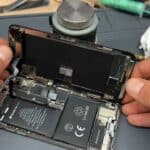iPhones have long been known for their sleek design and advanced features. Yet their repairability has often been a point of contention. Recent models have shown improvements, but iPhones still present challenges for DIY repairs.
Apple has made strides in making iPhones more repairable. The iPhone 14, for instance, boasts a design that’s easier to open and fix. But there’s a catch. Many repairs require Apple’s approval. You need to buy parts through their system and have the repair validated. Without this, you may face limited functionality and warnings.
The right to repair movement has pushed for more open repair options. Yet Apple’s tight control over parts and software remains a hurdle. This affects not just DIY enthusiasts but also independent repair shops. The debate continues: should iPhones be easier to fix?
| iPhone Model | Ease of Repair | Notable Changes |
|---|---|---|
| iPhone 15 | Moderate | Improved access |
| iPhone 14 | Easier | Redesigned interior |
| iPhone 13 | Challenging | Face ID issues |
| iPhone 12 | Difficult | Glass back |
The State of iPhone Repairability
iPhone repairability has evolved over the years. Apple’s approach to repairs impacts consumers and independent repair shops alike. Recent changes have brought both improvements and new challenges.
Repairability Scores and Indexes
iFixit, a popular repair guide website, assigns repairability scores to iPhones. These scores help consumers understand how easy or difficult it is to fix their devices. The iPhone 14 received praise for its improved hardware architecture.
Recent iPhone models have seen fluctuations in their scores. The iPhone 12 scored a 6 out of 10 for repairability. However, newer models like the iPhone 15 Pro have shown progress. These phones feature redesigned internal structures that make repairs easier.
The iPhone 15 series saw an increase in its repairability score from 4/10 to 7/10. This jump reflects Apple’s efforts to improve repair access.
System Configuration and Software Handshakes
Apple has introduced system configuration tools that affect repairs. These tools require software “handshakes” between replacement parts and the device. This process can complicate repairs for non-Apple technicians.
The launch of Apple’s Repair Assistant software has been a positive development. It helps repair shops and enthusiasts with the repair process. However, its benefits vary across iPhone models.
You might face challenges when trying to repair newer iPhones without Apple’s official tools. This can limit your options for independent repairs.
Aftermarket Versus Genuine Parts
The choice between aftermarket and genuine parts affects your repair options. Apple strongly encourages the use of genuine parts for repairs.
Using non-genuine parts can trigger warnings or limit device functionality. This practice has raised concerns among right-to-repair advocates.
| Part Type | Pros | Cons |
|---|---|---|
| Genuine | Full functionality, Apple warranty | Higher cost, Limited availability |
| Aftermarket | Lower cost, Wider availability | Potential compatibility issues, Warnings |
Some repair practices from Apple remain concerning for organizations like iFixit. These include restrictions on using aftermarket parts.
You should weigh the trade-offs when choosing between genuine and aftermarket parts for your iPhone repairs. Consider factors like cost, warranty, and device functionality.
Exploring Repair Options for iPhones
iPhone repairs can be done through various channels. Each option has its own benefits and drawbacks depending on your specific needs and situation.
Authorized Apple Store Services
Apple offers repair services at their retail stores and authorized service providers. These locations use genuine Apple parts and have access to specialized tools. Repairs done here maintain your warranty and ensure quality work.
Apple’s self-repair program allows you to order parts and tools for certain repairs. This option is best for tech-savvy users comfortable with detailed instructions.
Pricing can be higher at Apple stores compared to other options. Wait times may also be longer during busy periods.
| Repair Option | Pros | Cons |
|---|---|---|
| Apple Store | Genuine parts, warranty intact | Higher cost, potential wait |
| Self-repair | Official parts, lower cost | Requires technical skill |
Independent Repair Shops and Right to Repair
Independent shops often offer faster and cheaper repairs than Apple stores. Many use high-quality third-party parts to keep costs down.
The right-to-repair movement aims to make repair information and parts more accessible. This could lead to more repair options in the future.
Some shops may use lower quality parts. This can affect device performance or void your warranty. Research shops carefully before choosing one.
Do-It-Yourself Repairs and Guides
DIY repairs can save money if you have the skills. Websites like iFixit offer detailed repair guides and sell tools and parts.
You can learn a lot about your device through DIY repairs. It’s a good option for out-of-warranty phones or minor issues.
DIY repairs risk damaging your iPhone if not done correctly. They will likely void any remaining warranty. Only attempt repairs you’re confident in performing.
Challenges in iPhone Repairs
iPhone repairs face several obstacles that make them difficult for users and technicians alike. These issues stem from hardware design choices and software restrictions.
Parts Pairing and Software Locks
Apple’s parts pairing system creates significant hurdles for iPhone repairs. This system links components to the device’s logic board through software. When you replace a part, the iPhone may display warnings or lose functionality.
For example, replacing an iPhone 12 camera can trigger failure messages. The iPhone 13 went further, disabling Face ID completely after screen replacements. These software locks force users to seek official Apple repairs or use specialized tools.
To address this, Apple introduced Repair Assistant software. However, its benefits vary across iPhone models. Older devices may still face restrictions even with this tool.
Access to Replacement Parts
Getting genuine Apple parts for repairs can be challenging. Apple limits the availability of official components to authorized service providers. This restriction affects independent repair shops and DIY enthusiasts.
You might turn to third-party parts as an alternative. But these can vary in quality and may not work with Apple’s software checks. Using non-genuine parts often leads to warning messages or reduced functionality.
Apple has started a Self Service Repair program. This offers access to genuine parts and tools. Yet, the program’s scope remains limited to certain models and repairs.
Economic and Business Considerations
The cost of iPhone repairs influences repair decisions. Official Apple repairs can be expensive, especially for out-of-warranty devices. This high cost pushes some users to seek cheaper alternatives or replace their phones entirely.
For small repair businesses, Apple’s policies create economic challenges. They struggle to compete with Apple’s official repair services due to parts restrictions and software locks.
The right-to-repair movement has gained traction, pushing for more open repair policies. Some progress has been made, like Apple supporting California’s right-to-repair bill. But obstacles remain for fully open iPhone repairs.
| Repair Challenge | Impact on Users | Impact on Repair Shops |
|---|---|---|
| Parts Pairing | Limited DIY options | Need for specialized tools |
| Software Locks | Reduced functionality | Restricted repair capabilities |
| Parts Access | Higher repair costs | Difficulty sourcing components |
| Economic Factors | Pressure to replace devices | Challenges in competing with Apple |
Environmental and Regulatory Impacts
The repair practices of iPhones have significant environmental consequences and face increasing regulatory scrutiny. These factors are reshaping how consumers and manufacturers approach device longevity and repair rights.
Electronic Waste and Environmental Benefits
Repairing iPhones instead of replacing them reduces electronic waste. E-waste contains harmful materials that can pollute soil and water. By fixing your device you extend its life and decrease the need for new production. This cuts down on resource extraction and manufacturing emissions.
Repaired phones use fewer raw materials. This lowers the demand for mining rare earth elements. These elements often come from environmentally damaging processes. Longer-lasting devices also mean less packaging waste and reduced transportation emissions.
| Environmental Impact | New iPhone | Repaired iPhone |
|---|---|---|
| E-waste generated | High | Low |
| Resource consumption | High | Low |
| Carbon footprint | Large | Smaller |
Federal Trade Commission and Repair Legislations
The Federal Trade Commission (FTC) is pushing for broader repair access. They aim to enforce laws against unfair repair restrictions. This could make it easier for you to fix your iPhone or choose independent repair shops.
Several states have passed right-to-repair bills. These laws require manufacturers to provide repair tools and information. You might soon have more options to repair your iPhone locally. This could lead to faster and cheaper repairs.
The FTC’s actions may pressure Apple to change its repair policies. You could see more authorized repair locations and easier access to genuine parts. This shift would give you more control over your device’s lifespan.
Frequently Asked Questions
iPhone repairs involve several common processes and considerations. The repairability varies between models, and certain challenges arise when attempting DIY fixes. Warranty implications and cost-effectiveness also factor into repair decisions.
What steps are involved in a typical iPhone repair process?
A typical iPhone repair starts with diagnosing the issue. You then gather the necessary tools and replacement parts. Next, you carefully disassemble the device, replace the faulty component, and reassemble it. Testing ensures the repair was successful.
Screen replacements are among the most common repairs. They usually involve removing the display assembly, disconnecting cables, and installing a new screen.
How does the repairability of iPhones compare to other smartphones on the market?
iPhones generally have moderate repairability compared to other smartphones. Their conformity and ubiquity make finding parts easier. However, some models use proprietary screws and adhesives that complicate repairs.
Recent iPhone models have shown improvements in repairability. The iPhone 15 Pro, for example, features a redesigned internal structure that makes some repairs easier.
What are the common challenges faced when repairing an iPhone at home?
DIY iPhone repairs can be tricky. You may struggle with tiny screws and delicate components. Proper tools are essential but can be costly.
Waterproofing seals are often damaged during repairs, compromising the phone’s water resistance. Sourcing high-quality replacement parts can also be challenging for home repairs.
To what extent does repairing an iPhone affect its warranty?
Unauthorized repairs typically void Apple’s warranty. However, using genuine parts and Apple-authorized service providers keeps your warranty intact.
Third-party repairs may not affect your warranty for unrelated issues. But Apple may refuse service if they determine an unauthorized repair caused the problem.
Which iPhone models are known to be the easiest to repair?
Older iPhone models like the iPhone 6 and 7 are generally easier to repair. They have simpler internal designs and fewer adhesive-sealed components.
Newer models like the iPhone 12 and later have improved back glass repairability. However, their screen repairs can be more complex due to additional sensors.
Is it financially prudent to repair an older iPhone model?
The financial wisdom of repairing an older iPhone depends on several factors. Consider the repair cost versus the phone’s current value and your budget for a new device.
For minor issues like battery replacements, repairs are often cost-effective. However, for major repairs on very old models, upgrading to a new device might be more sensible in the long run.
| Repair Type | Average Cost (DIY Kit) | Apple Service Cost |
|---|---|---|
| Screen (iPhone 11 and older) | ~$100 | $129-$329 |
| Screen (iPhone 12 and newer) | ~$250 | $279-$379 |
| Battery | $50-$70 | $69-$99 |
This table compares average costs for common iPhone repairs using DIY kits versus Apple’s service pricing.






